The Mosque: Architectural Wonders and Cultural Impact in Dubai
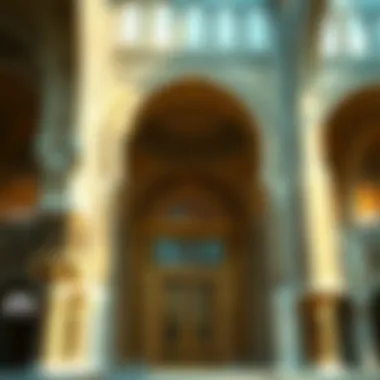
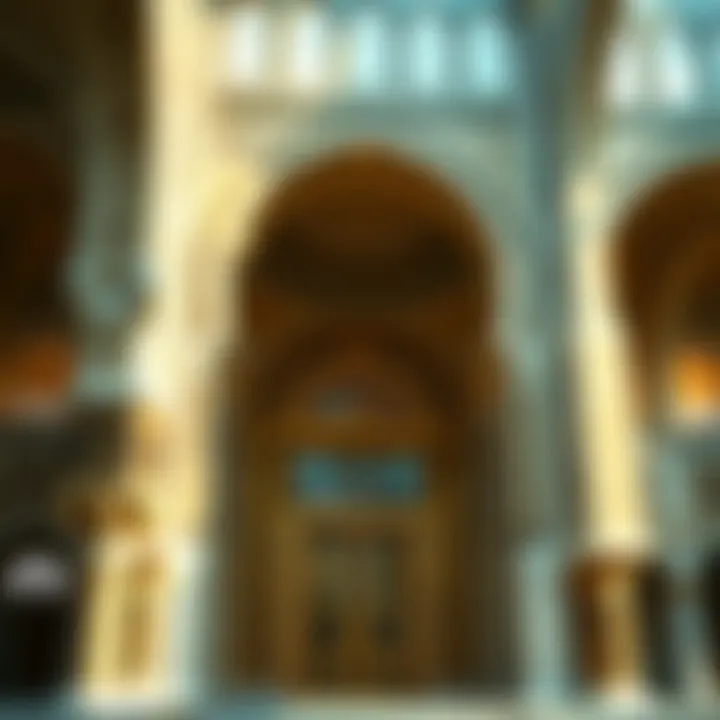
Intro
Dubai's architectural skyline is a symphony of modernity and tradition, with mosques standing as key notes in this visual orchestration. More than just places of worship, these structures embody a rich tapestry of history, culture, and community. With every brick and dome, they narrate stories of faith and resilience, inviting both locals and visitors to reflect on the city’s diverse identity.
As one meanders through the bustling streets of this vibrant metropolis, the graceful minarets and intricate tile work of the mosques capture one’s attention—not only for their mesmerizing beauty but also for their significance in the social fabric of the community. These sacred spaces foster connection, give solace, and offer a glance into the evolving narrative of a city that, while racing toward the future, holds on to its roots.
The architectural marvels of mosques in Dubai are not confined to their exterior splendor; they also play a critical role in shaping the urban landscape. Each mosque contributes uniquely to the character of its neighborhood, creating hubs of activity that harmonize with the surrounding environment. In exploring the mosque architecture and its profound impact on Dubai's cultural scene, this article serves to engage discerning readers who appreciate the intersection of religion, culture, and urban development.
By dissecting the history, styles, and essential functions of these structures, we aim to reveal how mosques fortify community bonds in a city marked by diversity and rapid growth.
Thus, join us as we embark on this exploration of Dubai's mosques—where architectural elegance meets cultural depth—a journey sure to illuminate the steadfast spirit and communal soul of this extraordinary city.
Prologue to Mosques in Dubai
The mosques of Dubai serve as not just places of worship but as vital components of the city's cultural landscape. They anchor the community, embody the heritage, and showcase stunning architectural designs that attract both locals and tourists alike. Understanding the role of mosques in Dubai is essential for anyone interested in the intricate tapestry that makes up this vibrant city.
Defining the Role of Mosques
Mosques in Dubai hold a multifaceted role, beginning with their primary purpose as sites for prayer and reflection. They act as a spiritual home where community members gather to engage in daily prayers, especially during the significant times of Ramadan and Eid celebrations. Beyond the prayer mats, mosques provide a sense of identity and belonging, especially crucial for expatriates living in this cosmopolitan hub.
Furthermore, they foster social activities, hosting educational programs and community events that deepen interpersonal connections. By serving as centers of learning, mosques educate the public on Islamic teachings and cultural heritage. This dual role of worship and education rather than mere architecture adds layers of significance to these structures.
Historical Overview
Dubai's history is rich and complex, and the evolution of its mosques mirrors the city’s growth. The earliest mosques were modest structures, built primarily to meet the spiritual needs of a small population. As Dubai transformed from a fishing village to a global metropolis, its mosques evolved too, reflecting changing architectural styles and technological advancements.
During the 19th century, the introduction of elaborate designs marked the onset of a new era - one that aimed to inspire awe and admiration. The mosques built in this period, such as the Jumeirah Mosque, became symbols of Dubai’s emerging identity. Today, the architectural choices—ranging from the ornate minarets to the vast courtyards—exemplify a blend of traditional Islamic and contemporary styles. Each structure tells a story, making the mosques not just places of worship, but also historical landmarks worthy of exploration.
In short, mosques in Dubai encapsulate the city's history, serve as social hubs, and maintain their importance amidst rapid urban development. Investing time to understand their roles offers deeper insights into the cultural essence of Dubai and its people.
Architectural Styles of Mosques
In the discussion of mosques, particularly in a vibrant city like Dubai, architectural styles play a pivotal role in shaping not just the physical landscape but also cultural identity. The way a mosque looks can convey its architectural heritage, link to past traditions, and even hint at its communal importance. This section explores the traditional Islamic architecture and modern adaptations seen in Dubai's mosques, evaluating how these elements contribute to their significance in contemporary society.
Traditional Islamic Architecture
Traditional Islamic architecture is rich and varied, characterized by some quintessential elements that define mosques across the world.
Domes
A dome is more than just a physical structure; it is often viewed as a symbol of the heavens. The classic shape of a dome creates an expansive visual appeal, commonly adorned with intricate mosaics and calligraphy. One key feature of these domes is their epic scale, often towering over the rest of the mosque. This grandiosity is essential in attracting attention and admiration, making them a popular feature in design.
While the dome showcases the artistic sense of the period, it also benefits the acoustics within the prayer halls, allowing sermons to resonate beautifully among the congregation. However, constructing large domes can pose challenges, such as the need for specialized engineering to ensure stability and support, particularly in extreme weather conditions common in Dubai.
Minarets
Minarets are another hallmark of mosque architecture, serving both aesthetic and functional purposes. Their tall and slender structures not only dominate the skyline but also symbolize the call to prayer, inviting worshippers to gather. A standout characteristic is their height—minarets must be visible from various points which accentuates their significance within the urban fabric.
While minarets enhance the visual profile of a mosque, they also come with certain considerations. For instance, the materials used must combine durability with architectural finesse to withstand the elements and remain majestic through the years. Additionally, the need for accessibility for both maintenance and visitor engagement can sometimes complicate their design.
Courtyards
Courtyards provide an important transitional space between the exterior and the spiritual interior of the mosque. These open areas often serve as gathering spots for community activities and allow for greater flexibility in accommodating worshippers. A key characteristic of courtyards is how they create a breath of fresh air—a concept especially beneficial in the otherwise dense urban setting of Dubai.
Courtyards carved in traditional styles often include lush landscaping and fountains, presenting a serene escape from the bustling city outside. However, this feature also requires continuous upkeep to maintain its beauty and functionality, which can be resource-intensive for mosque administrators.
Modern Adaptations
Modern adaptations in mosque architecture reflect not just a response to changing aesthetic tastes but also the practicalities of life in a rapidly developing urban environment like Dubai.
Innovative Designs
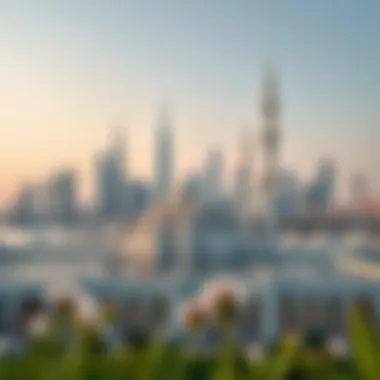
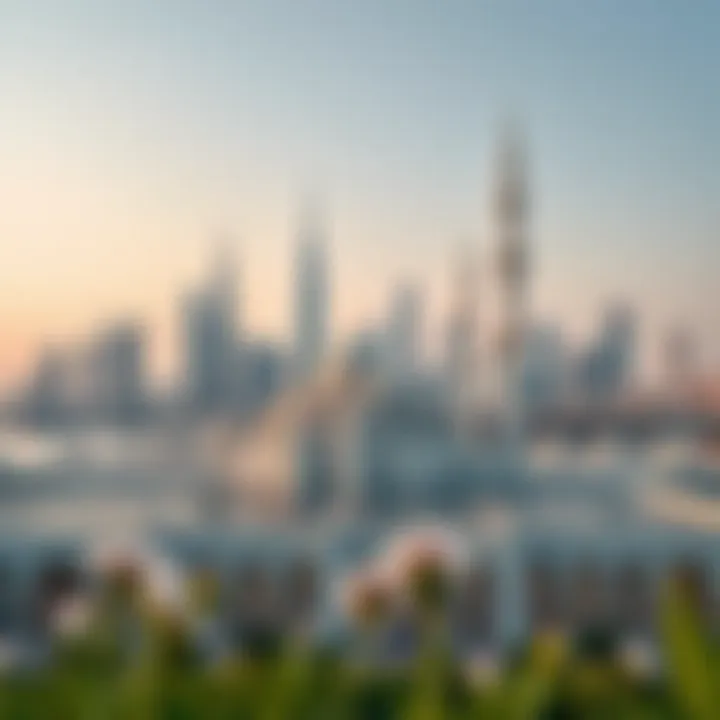
The term 'innovative designs' in mosques is emerging with free-form structures and cutting-edge materials. These designs often break away from the classical forms, instead opting for creative and sometimes unexpected shapes, making them instantly recognizable. One benefit of such designs is that they often attract a broader demographic, including tourists and architecture enthusiasts, who might not otherwise engage with traditional religious structures.
Moreover, these innovative aspects enable architects to incorporate technology you wouldn't see in older structures, improving energy efficiency and visitor engagement simultaneously. However, the drawback is that some purists might view these designs as straying too far from religious orthodoxy.
Eco-friendly Materials
Using eco-friendly materials is quickly becoming a cornerstone of modern mosque construction. Materials like recycled metals, sustainable woods, and solar panels not only promote environmental responsibility but also resonate with a younger audience interested in sustainability.
The unique features of such materials include durability and energy efficiency. For example, solar panels provide the mosques with energy, reducing operating costs, while also projecting an image of modernity and ethos that aligns well with Dubai's global financial aspirations. A challenge, however, lies in sourcing materials that meet aesthetic demands without compromising on performance.
The architectural dialogue between tradition and modernity in mosque design symbolizes a broader cultural synthesis unique to Dubai's identity.
This section shows the intricate balance between preserving traditional forms while accommodating contemporary needs. As we move forward, it becomes increasingly important to recognize not just the structures themselves, but the narratives they embody.
Cultural Significance of Mosques
Mosques in Dubai stand as more than just places of worship; they are vital threads woven into the social fabric of the community. Their cultural significance expands beyond religious practices, influencing social interactions, educational developments, and public celebrations. Understanding this layered importance is crucial for anyone wishing to grasp the essence of Dubai's identity. In this section, we dive into the role of mosques as community gathering spaces and their function as venues for significant cultural events and festivals.
Community Gathering Spaces
At the heart of mosque culture lies the idea of community. These sacred spaces serve as gathering points where individuals not only come together for prayers but also connect on a social level. Think of the mosque as a lively town square, bustling with conversations and camaraderie. Here, people share news, support each other, and form alliances that often extend beyond the mosque walls.
The mosque offers a sense of belonging, especially for newcomers and expatriates. In the diverse melting pot that is Dubai, mosques often become sanctuaries for various cultural backgrounds. They encourage dialogue, facilitate exchanges, and help in building a cohesive community. Moreover, many mosques host events aimed at younger generations, focusing on education and character building, which underscores their pivotal role in societal development.
Cultural Events and Festivals
Eid Celebrations
Eid celebrations, especially Eid al-Fitr, hold a special place in the hearts of many. For Muslims, Eid marks the conclusion of Ramadan, a month of fasting, reflection, and prayer. During this festival, mosques brim with activity, as community members gather to perform special prayers, exchange greetings, and enjoy feasting together.
The communal prayer conducted in the mosque serves as a beautiful representation of unity among the followers, allowing everyone to celebrate their faith collectively. A notable characteristic of these celebrations is the festive spirit that envelops the community, with vibrant decorations, delicious meals, and a shared atmosphere of gratitude and joy. Offering charity, known as Zakat al-Fitr, also forms a significant part of the celebrations, reinforcing the community's responsibility towards those in need.
However, hosting large gatherings does come with its unique challenges. Coordination and space become crucial, especially as the urban population of Dubai continues to increase. The mosques must manage these events efficiently to accommodate everyone while maintaining a spirit of inclusiveness.
Ramadan Activities
During Ramadan, mosques shift gears entirely, becoming the focal point of religious observance and community interaction. The iftar meals—the breaking of the fast—are often organized within mosque premises, drawing individuals together to share not just food but moments of spiritual reflection. Participating in communal iftars provides a unique opportunity for individuals from various backgrounds to connect, fostering a sense of solidarity and understanding.
Unique features of these Ramadan activities include nightly prayers called Tarawih, which draw larger crowds as the month progresses. Participants find comfort in gathering to pray and listen to lessons from the Quran. Additionally, many mosques host educational programs and discussions focused on the themes of the month, such as charity, compassion, and gratitude.
Yet, the extensive activities require resources and careful planning to ensure accessibility for all. As the community continues to grow, so too does the need for mosques to adapt, illustrating their evolving significance in the social landscape of Dubai.
"Mosques are not just places for worship; they are vital centers for community engagement and cultural preservation in Dubai."
In summary, the cultural significance of mosques in Dubai cannot be overstated. They serve as gathering spaces and actively foster bonding through events and festive celebrations, weaving tightly into the community's daily life.
The Mosque as a Hub of Learning
Mosques in Dubai serve not only as places of worship but also as vibrant centers of learning. Through their educational programs, they become pivotal in transmitting knowledge about Islamic teachings and values. This multifaceted role fosters a sense of community and belonging, allowing individuals to engage with their faith on a deeper level. The concept of mosques as educational institutions underscores their significance, tying together the pillars of faith, culture, and social responsibility within the fabric of Dubai's society.
Educational Functions
Classes on Islamic Studies
Classes on Islamic studies held in mosques cover a wide range of topics, giving participants insights into various aspects of their faith. They usually encompass subjects like the Quran, Islamic history, and the principles of Sharia law. One standout characteristic of these classes is their accessibility; people from all walks of life can join, fostering inclusivity. As a result, participants—from seasoned scholars to curious newcomers—find themselves engaged in meaningful discussions.
A unique feature of these classes is the opportunity for one-on-one interactions with knowledgeable instructors. This personalized approach allows attendees to ask questions and clarify doubts in an inviting environment. However, challenges exist. Not everyone may feel comfortable asking questions in an open setting, which could hinder the learning experience for some.
Youth Programs
Youth programs organized by mosques play a vital role in nurturing the next generation. These programs engage younger individuals through activities like group discussions, community service, and mentorship. The primary characteristic that sets them apart is their focus on practical applications of Islamic teachings, making religion relevant to everyday life.
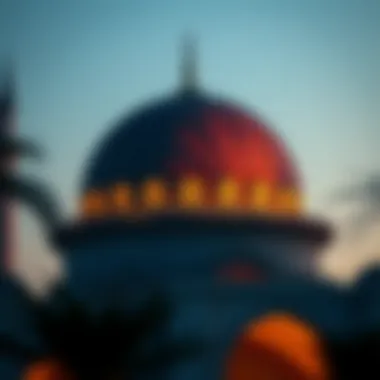
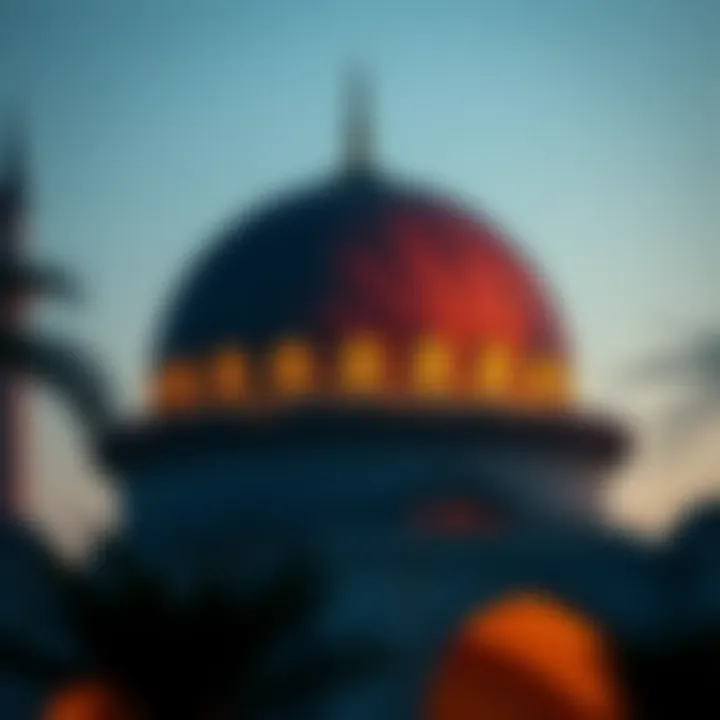
These programs are popular as they often incorporate modern technology and creative methods to engage young minds. For instance, some mosques use apps and online resources to supplement learning. This innovative approach not only attracts more youths but also promotes the idea that faith is adaptable in today’s world. However, balancing traditional values with contemporary practices can sometimes lead to clashes, raising questions about the effectiveness of the programs.
Role in Interfaith Dialogue
Mosques in Dubai play a crucial part in fostering interfaith dialogue. They host events that bring together people from various backgrounds, encouraging understanding and cooperation among different religions. Through discussions, workshops, and community service projects, mosques facilitate connections that break down barriers. This inclusive approach goes beyond mere tolerance; it cultivates mutual respect and collaboration.
A notable benefit of these interfaith initiatives is the opportunity to dispel misconceptions about Islam. When people of different faiths come together to learn about one another's beliefs, it enriches the community's tapestry. However, interfaith dialogues can be sensitive, requiring careful facilitation to ensure productive discussions that do not cross boundaries. Overall, this endeavor enhances the mosque's role as a beacon of communal harmony.
Tourist Interest and Economic Impact
Dubai's mosques aren't just places of worship; they are major tourist attractions that draw visitors from around the globe. This influx of tourists significantly boosts the economy while showcasing the rich cultural tapestry of the city. Mosques serve as totems of architectural splendor, intertwining spirituality with art, history, and community essence. They act as portals into a world where tradition meets modernity, embodying the very spirit of Dubai.
The presence of these magnificent structures invites an exploration of their beauty and purpose. Tourism related to mosque visits contributes to the local economy through various avenues. Visitors often engage with local businesses, from guides offering insights about the sites to shops selling traditional goods. Furthermore, mosques tend to galvanize the hospitality sector, encouraging visitors to stay overnight, thereby supporting hotels and restaurants.
Key Mosques as Tourist Attractions
Sheikh Zayed Grand Mosque
The Sheikh Zayed Grand Mosque is a stellar example of architectural brilliance, exemplifying the fusion of various cultural elements. This mosque is not only an iconic symbol of Abu Dhabi but also a major highlight for tourists venturing into Dubai. One of its key characteristics is the sheer scale of its structure, which can accommodate over 40,000 worshippers.
Visitors are often struck by the striking features of the mosque, such as its 82 magnificent domes and 1,000 columns, made of pure marble. Its reflective pools amplify the serene atmosphere, creating breathtaking views, especially during the twilight hours. An incredible tidbit is the mosque's grand chandelier, which is one of the largest globally, hanging gracefully and shimmering with thousands of crystals.
While the mosque is undeniably beautiful, accessibility can sometimes be a challenge. Tourists are encouraged to adhere to specific dress codes, which may come as a surprise to some first-time visitors. However, this regulation plays a crucial role in educating tourists about respecting local customs. On the whole, the Sheikh Zayed Grand Mosque stands as an essential reference point for those who wish to grasp the artistic and cultural significance within Dubai.
Jumeirah Mosque
Jumeirah Mosque, another celebrated mosque in Dubai, is often recognized for its unique architectural style that melds traditional Safavid design elements with a contemporary twist. This mosque is a popular choice for tourists given its welcoming atmosphere. Unlike many mosques, Jumeirah opens its doors to non-Muslims, offering guided tours that shed light on Islamic traditions and practices.
A stunning feature of the mosque is its intricate hand-carved stonework and the beautifully lit minarets that create a picture-perfect scene against the Dubai skyline. This makes the mosque not just a place for worship but also a prime spot for photographers and visitors eager to capture the essence of Dubai.
The hands-on experiences provided by Jumeirah Mosque tours enrich the understanding of Islam for visitors. However, it's essential to note that tours are limited in number, so advance planning may be necessary to ensure inclusion. Nevertheless, the welcoming spirit and educational focus of this mosque make it a significant player in both the tourist landscape and the cultural education of those who visit.
Economic Contributions
Mosques contribute significantly to Dubai's economy. The influx of tourists and local visitors stimulates various sectors, creating jobs and fostering engagement in cultural tourism. For instance, local artisans benefit from increased demand for handcrafted goods, often sold in nearby markets. Additionally, the presence of these stunning religious sites enhances property values in their vicinity, making real estate a thriving venture.
Moreover, mosques offer venues for community events, which can attract a diverse audience, further solidifying their role as economic hubs in the urban landscape. In summary, mosques are not only bastions of faith but are fundamental components of Dubai's economical and cultural vitality, creating rippling effects throughout the city.
Mosques in Urban Planning
The role of mosques in the urban planning landscape of Dubai intertwines with cultural, architectural, and social strands that are pivotal to the city's identity. As the skyline of Dubai tallies more remarkable structures, mosques serve not only as spiritual havens but as central nodes in the urban fabric. Urban planners regard these places as essential elements that shape community dynamics, enhance aesthetic value, and address socio-religious needs within a growing metropolis. The integration of mosques into urban settings brings along several notable benefits, and understanding this symbiosis is critical for investors, expats, agents, and property managers who navigate Dubai's bustling real estate market.
Integration with City Infrastructure
Mosques often form the backbone of the infrastructure within urban settings, reflecting the intricate balance between spirituality and modernity. Their integration into the existing city infrastructure is not just a matter of placement; it involves careful consideration of accessibility and community interaction.
- Accessibility: For many residents, ease of access to a mosque is akin to reaching any other public facility. Thoughtful planning ensures mosques are strategically placed near residential areas, enhancing their role as community hubs. It fosters an environment where worshippers can gather without hassle, reinforcing community bonds.
- Public Transportation: With the rise of diverse public transport options available in Dubai, incorporating mosques into transport planning can boost foot traffic, thus exhibiting their appeal as cultural points of interest.
- Landscaping and Public Spaces: Often escorted by gardens and open areas, mosques provide recreational spaces for families and individuals. These green belts enhance not only the mosque's aura but also improve the overall urban environment, creating an inviting appeal for both locals and visitors.
This thoughtful integration thus creates a harmonious urban landscape where mosques transcend their primary religious function, becoming integral to city life.
Impact on Property Values
The historical significance and cultural resonance of mosques inevitably affect nearby property values. As investors eye the rapidly evolving neighborhoods of Dubai, the presence of a mosque plays a critical role in property dynamics.
- Higher Property Values: Properties located near mosques can often experience a surge in value. This upward trend stems from the perceived convenience for residents who wish to engage in religious activities easily. For expats and buyers, living near a mosque may be particularly appealing.
- Attraction to Diverse Demographics: Mosques cater not solely to the local Muslim population; they also attract a variety of visitors, from tourists curious about Islamic architecture to residents seeking cultural experiences. Hence, neighborhoods housing significant mosques become more desirable, influencing property demand positively.
- Social Community: The presence of a mosque contributes to societal cohesion, which in turn, solidifies the attractiveness of an area for potential buyers. A neighborhood known for its vibrant community and welcoming atmosphere usually translates into stronger property investment opportunities.
"The very essence of Dubai's cultural identity is encapsulated in its mosques, acting as pillars that uphold both spiritual and urban integrity."
As urban planning continues to evolve in Dubai, the esteemed role of mosques will likely expand. Recognizing this multifaceted influence is crucial for stakeholders in the real estate market as they navigate a landscape rich with opportunities and cultural significance.
Challenges Facing Mosques Today
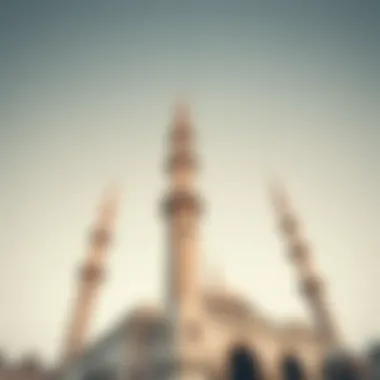
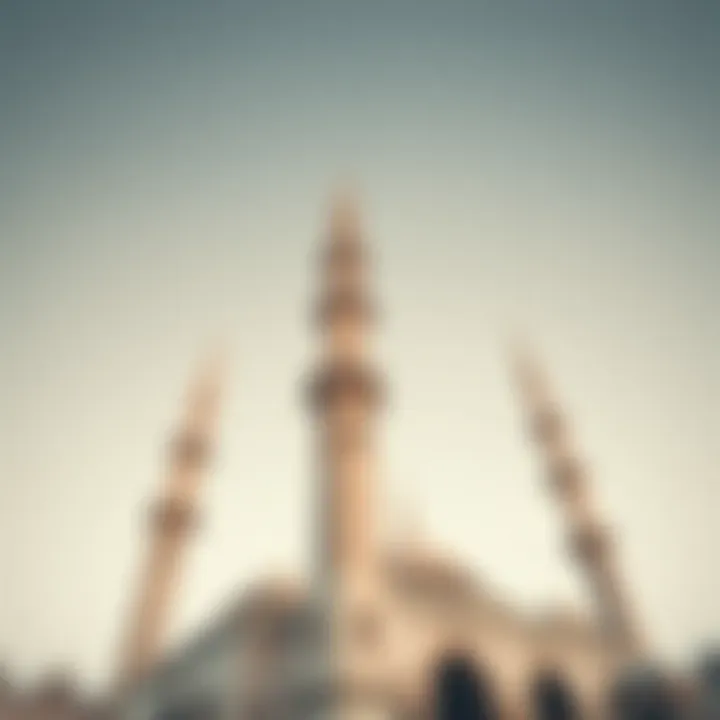
Mosques, as pivotal pillars in both cultural and social frameworks, find themselves navigating a landscape fraught with challenges that are both complex and varied. In a time when globalization is reshaping local identities and norms, the relevance and function of mosques are continuously scrutinized. Understanding these challenges is crucial, not only for religious leaders but also for investors, expats, agents, managers, and buyers who are interested in the cultural tapestry of Dubai.
Social and Political Pressures
The mosques in Dubai aren’t only places of worship; they are reflections of the community's ethos and values. Yet, they often face social and political pressures that can distort their functions. With the rapid urbanization of the city and the influx of expatriates from various backgrounds, mosques sometimes serve as the backdrop for tensions relating to cultural identity.
The Middle Eastern political landscape adds another layer of complexity. Changes in regional politics can lead to shifts in public sentiment, impacting how mosques are perceived. Challenges can arise from both governmental policies and societal attitudes which may sometimes starkly clash with traditional Islamic values.
Additionally, there’s an undercurrent of societal pressure. Many Muslims feel an obligation to represent their faith positively, and any misperception can lead to heightened scrutiny of mosques, potentially alienating communities.
Maintenance and Preservation Issues
Caring for a mosque involves much more than simple upkeep; it is about maintaining its integrity as a cultural symbol. With many mosques in Dubai being historic sites, the preservation of their architectural and cultural significance becomes paramount. The challenge lies in balancing modern facility needs with the preservation of traditional designs.
This task is not straightforward. The influx of visitors can lead to wear and tear, necessitating maintenance that respects both the aesthetic and historical value of these structures. Lack of funds can compound these issues, limiting the ability to secure expert advice on preservation techniques.
Moreover, as urban landscapes evolve, there is pressure to modernize which could lead to a departure from traditional styles that define these sacred places. For example, incorporating modern technologies or eco-friendly materials in renovations must be handled delicately to avoid overwhelming the mosque's cultural significance.
The delicate balance between preservation and modernization remains a significant challenge, influencing not just the structure of the mosque but also the community connected to it.
To summarize, mosques in Dubai face a myriad of challenges that can threaten their cultural and religious significance. By understanding these social, political, and preservation issues, stakeholders can better appreciate the essential roles these buildings play in the vibrant tapestry of Dubai's society.
The Future of Mosques in Dubai
Dubai stands at a juncture of tradition meeting innovation, particularly in the realm of mosque architecture and community engagement. As the city continues to grow and evolve, the future of mosques will likely reflect broader changes in society, embracing both technological advancements and cultural diversities. This section delves into the anticipated innovations in mosque design and the evolving roles of these sacred spaces amid changing social dynamics.
Innovative Architectural Trends
The architectural landscape of Dubai has always been bold and forward-thinking, and the future of mosques is no exception. One trend expected to emerge is the integration of smart technologies into mosque designs. This could include advanced energy efficiency systems or interactive features that allow worshippers to engage deeply with their spiritual environment.
For instance, the use of solar panels is becoming increasingly popular. They not only reduce the carbon footprint but also symbolize a commitment to sustainability, echoing the Islamic principle of stewardship of the earth. Extensive use of glass and open spaces could foster a sense of connection between the indoor sanctuary and the natural outside world. Furthermore, some mosques in Dubai may adopt modular designs enabling them to adapt to varying community needs and preferences.
- Sustainable materials: Using bamboo or recycled resources can reflect Islamic teachings about nature and human responsibility.
- Virtual spaces: Advanced technology may even create virtual platforms for worship and community gatherings, appealing to younger generations who are more digitally inclined.
This shift towards flexibility and sustainability in mosque architecture signifies not just a trend but a transformation in how sacred spaces are perceived and utilized within a rapidly urbanizing context.
Evolving Social Roles
Mosques in Dubai are also poised to expand their social roles significantly in the coming years. Once primarily viewed as places strictly for worship, these structures are starting to take on additional functions as community centers. This change can be attributed to the need for social cohesion in a diverse city where cultures and traditions intermingle.
Future mosques could serve as hubs for interfaith dialogue and cultural exchange. These centers may organize workshops, classes, and forums that encourage understanding among different communities, bridging gaps that exist in multicultural settings. Also, the role of mosques as spaces for discussion is vital in promoting peace and tolerance.
- Community support initiatives: Future mosques might offer services ranging from counseling to educational programs, helping the local population in various aspects of life.
- Public health outreach: Given recent global events, mosques might become focal points for health education and community well-being, addressing public health concerns directly within a trusted environment.
As these institutions evolve to meet contemporary needs, they will play an essential role in fostering unity, understanding, and resilience in Dubai's society.
The future of Dubai’s mosques hinges on their ability to adapt, not just architecturally but socially, ensuring they remain relevant and influential in the lives of their communities.
With these innovations in architecture and social engagement, the future indeed looks promising for mosques in Dubai. They may very well become more than just spiritual havens – they could emerge as pivotal pillars of community cohesion and progressive thought.
The End
The journey we took through the architectural and cultural landscape of mosques in Dubai leaves us with a rich understanding of their multifaceted significance. These structures are more than just visual landmarks; they embody the spiritual essence and historical narrative of the emirate. Each mosque we explored, with its unique architectural elements and community roles, contributes to the diverse mosaic that characterizes Dubai.
Summarizing the Impact
The mosques in this city serve as crucial social hubs, promoting community cohesion amid the fast-paced urban development. Their architectural prowess, while standing tall against the modern skyline, pays homage to traditional Islamic values and aesthetics. For instance, the Sheikh Zayed Grand Mosque captures the eye with its intricate domes and majestic minarets, symbolizing an open invitation to both worshippers and tourists alike. This communal spirit fosters unity in diversity, allowing newcomers and locals to gather for a common purpose: to seek knowledge, engage in worship, or simply appreciate the beauty surrounding them.
In summary, mosques are not merely places of prayer; they are essential elements in Dubai's social fabric. They foster connections between people of different backgrounds, acting as a bridge between tradition and modernity, while also elevating the cultural status of the region.
Call to Consider Future Developments
Looking ahead, the role of mosques may continue to evolve, adapting to new societal dynamics and technological advancements. As urbanization marches on, the incorporation of innovative designs and eco-friendly practices in mosque architecture could pave the way for more sustainable models. These changes are not just beneficial for the environment but may also resonate deeper with both younger generations and expats, who are increasingly valuing sustainability.
Moreover, there is a growing opportunity to enhance inclusivity through interfaith dialogues and cultural events held within mosque premises. As the world becomes more interconnected, these venues have the potential to become platforms for constructive conversations across faiths, fostering a culture of understanding and respect.
"Architecture is a visual art, and the buildings speak for themselves." - Julia Morgan
This balance of heritage and innovation will ultimately define the role of mosques in Dubai's continued growth.











